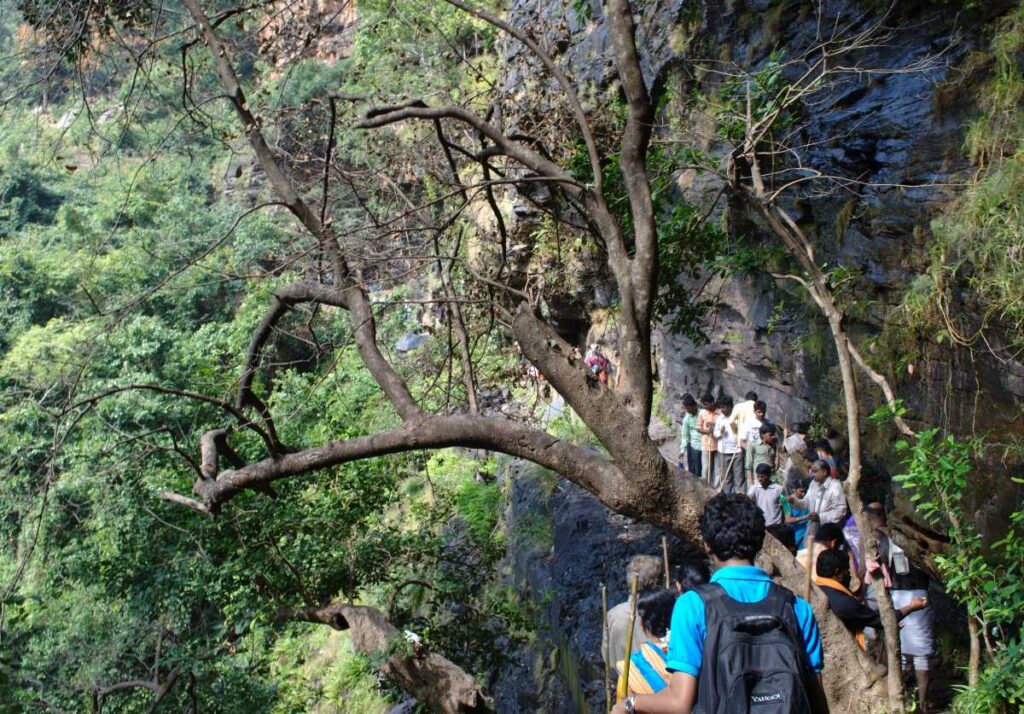Your cart is currently empty!
Ahobilam is a famous pilgrimage site located in the Nallamala Hills of Andhra Pradesh, India, known for being the sacred abode of Lord Narasimha, an avatar of Lord Vishnu. It is one of the most important Narasimha Kshetras (holy places dedicated to Narasimha) and is considered especially significant among the 108 Divya Desams (sacred temples) of the Vaishnavite tradition.
The Legend of Ahobilam
The legend of Ahobilam is deeply rooted in Hindu mythology, particularly in the story of Lord Narasimha from the Bhagavata Purana and Vishnu Purana. The story revolves around the fourth avatar of Vishnu, who manifests as Narasimha, a half-lion and half-man, to save his devotee Prahlada and defeat the demon king Hiranyakashipu.
Hiranyakashipu’s Reign
Hiranyakashipu, the ruler of the Asuras (demons), performed severe penance to attain immense power and invincibility. As a boon from Lord Brahma, he could not be killed by any human, animal, or god, neither indoors nor outdoors, neither by any weapon nor during day or night. This made him arrogant, and he considered himself invincible, forbidding anyone from worshipping Vishnu.
However, his son, Prahlada, was a devout follower of Lord Vishnu. Despite Hiranyakashipu’s attempts to kill him and deter him from his faith, Prahlada remained steadfast in his devotion. Unable to tolerate his son’s unwavering devotion to Vishnu, Hiranyakashipu challenged Prahlada, asking him if his god was present everywhere, even in a pillar.
The Manifestation of Narasimha
When Hiranyakashipu struck the pillar with his mace, Lord Vishnu manifested from it in the fierce form of Narasimha, a being neither human nor animal. Narasimha then dragged Hiranyakashipu to the threshold of the courtyard (neither inside nor outside), placed him on his lap (neither on earth nor in the sky), and killed him at twilight (neither day nor night) using his claws (neither a weapon nor non-weapon).

The Nine Narasimha Forms at Ahobilam
Ahobilam is believed to be the site where Lord Narasimha descended to slay Hiranyakashipu and protect Prahlada. The region is known for the presence of nine forms of Narasimha, collectively called the Nava Narasimha, enshrined in different temples across the Ahobilam hills. Each form represents a different aspect of Narasimha’s divine power:
- Jwala Narasimha – The fierce form of Narasimha emerging from the pillar.
- Ahobila Narasimha – The form in which Narasimha is worshipped after slaying Hiranyakashipu.
- Malola Narasimha – A peaceful and benevolent form, showing Narasimha’s love for his devotees.
- Kroda (Varaha) Narasimha – A form that combines Narasimha and Varaha (the boar avatar).
- Karanja Narasimha – Narasimha seated beneath a Karanja tree.
- Bhargava Narasimha – Narasimha worshipped by the sage Bhargava.
- Yogananda Narasimha – Narasimha in a meditative posture, teaching Prahlada.
- Chatravata Narasimha – Narasimha under a Peepal tree, protecting his devotees.
- Pavana Narasimha – The most peaceful form of Narasimha, symbolizing forgiveness.
The central shrine at Ahobilam, called Ahobila Narasimha Swamy temple, is considered the most important of these temples. The name Ahobilam itself is derived from two Sanskrit words: “Aho” meaning “wonder” or “exclamation” and “Bhilam” meaning “cave.” Legend has it that the devas, witnessing the fierce form of Narasimha, exclaimed “Aho! Balam” (Oh! What strength!) when they saw his power, giving the place its name.

The Role of the Ahobilam Matha
Ahobilam is also home to the Ahobilam Matha, a prominent Vaishnava monastic institution. It was established by Sri Adivan Satakopa Yatindra Mahadesikan, a revered saint in the 14th century, to promote the worship of Narasimha and spread the teachings of Vishishtadvaita, a school of philosophy associated with Sri Ramanuja.
Pilgrimage and Trekking
The Ahobilam temple complex is divided into Lower Ahobilam and Upper Ahobilam. While Lower Ahobilam is more accessible, Upper Ahobilam involves a steep trek through rugged terrain, which takes devotees to the more remote shrines of Narasimha. The pilgrimage to all nine shrines is considered highly auspicious and a test of devotion and endurance.
Ahobilam holds a special place in the hearts of devotees, blending mythological significance with natural beauty, and offering a spiritual experience amidst the scenic hills and forests.

